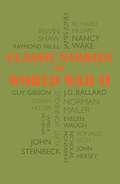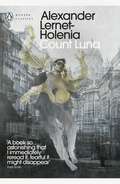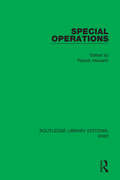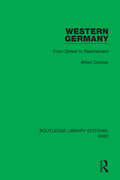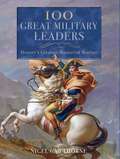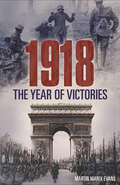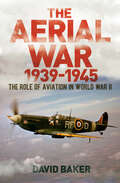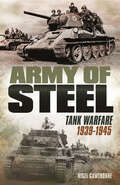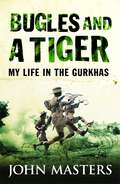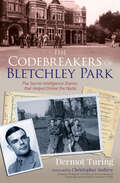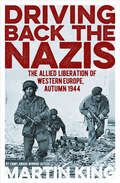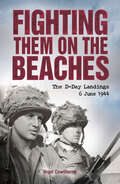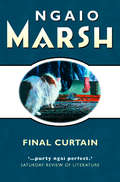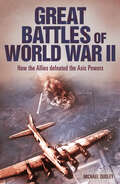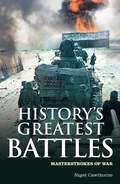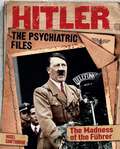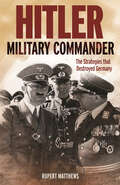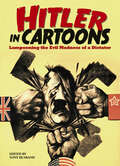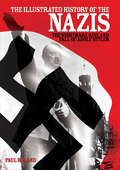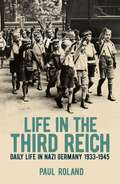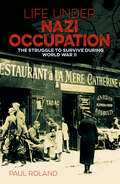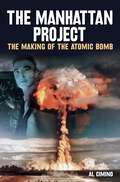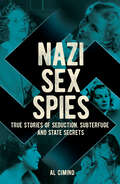- Table View
- List View
Classic Stories of World War II: Tales of History's Most Heroic and Harrowing Experiences
by Classic Stories Of World War IIClassic Stories of World War II is a collection of fiction and non-fiction excerpts from the works of world-class authors who lived through the conflict. Authentic and impassioned stories reveal the heroism, survival, defeat and triumph of one of the most shocking wars this world has ever seen. Contents include: IRWIN SHAW A Perfect Morning (from The Young Lions) J. G. BALLARD Lunghua Camp (from Empire of the Sun) JAMES JONES The Big Day (from From Here to Eternity) JAMES A. MICHENER The Landing at Kuralei (from Tales of the South Pacific) RICHARD HILLARY Shall Live for a Ghost? (from The Last Enemy) KURT VONNEGUT Billy Pilgrim (from Slaughterhouse Five) EVELYN WAUGH Battalion in Defence (from Officers and Gentlemen) NORMAN MAILER Anopopei (from The Naked and the Dead) GUYGIBSON, VC Some were Unlucky(from Enemy Coast Ahead) JOSEPH HELLER Major Major Major Major(from Catch 22) RAYMOND PAULL The Invasion of Papua (from Retreat from Kokoda) RONALD SETH Stalingrad- the Story of the Battle (from Stalingrad-Point of Return) NANCY WAKE The White Mouse and the Maquis d'Auvergne (from The White Mouse) JOHN STEINBECK The Invaders (from The Moon is Down) NICHOLAS MONSARRAT The Compass Rose (from The Cruel Sea) JOHN HERSEY Hiroshima - The Fire (from Hiroshima)
Count Luna
by Alexander Lernet-Holenia'A book so astonishing that I immediately reread it, fearful it might disappear' Patti SmithThe war is over but Alexander Jessiersky, a wealthy Austrian aristocrat and industrialist, is haunted by guilt over the neighbour he inadvertently sent to a concentration camp, Count Luna. What's more, he is convinced that Luna survived - and is out to get his revenge. So begins a wild, weird cat-and-mouse chase that takes him and his shadowy nemesis through windswept valleys, eerie houses and, eventually, Rome's catacombs, as an increasingly paranoid Jessiersky asks himself: will Luna stop at nothing to exact his bloody vengeance? Crazed, raging and darkly comic, Count Luna is a reckoning with postwar guilt, and an irresistible tale of the uncanny.'Like Kafka ... Lernet-Holenia weaves his most intimate hopes and dreams ... with exquisitely imagined detail' Chicago Tribune
Special Operations (Routledge Library Editions: WW2 #33)
by Patrick HowarthThis book, first published in 1955, collects together accounts of some of the men and women who served as members of the remarkable S.O.E. This organisation was set up by Britain to encourage, help and organise resistance movements in occupied countries, and this book provides a valuable record of the types of people involved, and the work that they undertook.
Special Operations (Routledge Library Editions: WW2 #33)
by Patrick HowarthThis book, first published in 1955, collects together accounts of some of the men and women who served as members of the remarkable S.O.E. This organisation was set up by Britain to encourage, help and organise resistance movements in occupied countries, and this book provides a valuable record of the types of people involved, and the work that they undertook.
Western Germany: From Defeat to Rearmament (Routledge Library Editions: WW2 #43)
by Alfred GrosserThis book, first published in 1955, examines the total economic, political and social breakdown that Germany suffered in the last year of the Second World War and in its immediate aftermath, and the beginnings of the recovery in the Western half of the now-divided nation. The process of ‘denazification’ is analysed, as are the policies of the occupying powers and the subsequent political stability and economic expansion.
Western Germany: From Defeat to Rearmament (Routledge Library Editions: WW2 #43)
by Alfred GrosserThis book, first published in 1955, examines the total economic, political and social breakdown that Germany suffered in the last year of the Second World War and in its immediate aftermath, and the beginnings of the recovery in the Western half of the now-divided nation. The process of ‘denazification’ is analysed, as are the policies of the occupying powers and the subsequent political stability and economic expansion.
100 Great Military Leaders: History's Greatest Masters of Warfare
by Nigel CawthorneBeginning with Leonides of Sparta, who died at Thermopylae in 480 b.c.e., and ending with General Giap, a Vietnamese leader; Moshe Dayan, commander of the Israeli Defense Force during the 1967 Six-Day War; and Colin Powell, 100 Great Military Leaders provides an informative overview of the careers and battles of one hundred military commanders and their places in history. Divided by eras, the material covers the ancient world, the Anglo-Saxons and the Vikings, the Middle Ages, the Napoleonic period, the American War of Independence and the Civil War, the two World Wars, and the postwar conflicts.Each entry provides a chronology of major events as well as a summary of achievements. The entries, both fascinating and easy to read, succeed in providing a clear yet nuanced picture of the role of the individual in historical events.An engaging and thought-provoking book, full of facts, pertinent quotations, and anecdotes, 100 Great Military Leaders is sure to prove of interest to a wide range of readers.
1918: The Year of Victories
by Martin Marix EvansAt the outset of 1918 Germany faced certain defeat as a result of Allied technical innovation in tanks and aircraft, and the American entry into the war. Victory could only be gained by the immediate application of overwhelming force in new tactical form; the 'fire-waltz' artillery barrage and the storm-trooper infantry attack. 1918 examines both the Germans' tactics and the Allies' preferred solution to fighting this war, the combination of artillery, tanks, infantry and aircraft, and argues that this reached a level of sophistication in command and control never before achieved. The war of attrition was far from over, but as more Americans arrived in France the ghastly cost became affordable. For the Germans, it became a question of whether they could negotiate an armistice before their armies were utterly destroyed.
The Aerial War: The Role of Aviation in World War II
by Dr David BakerThe war is a war of machines; it will be won on the assembly line. - Lord Beaverbrook, Minister of Aircraft ProductionJust as vital as the battle on land or the struggle at sea, the air war ultimately tipped the balance of power in World War II. Many campaigns rode on the capabilities of their airforce, as British Spitfires were pitted against Messerschmitt Bf 109s and Japanese Zeros. Aerospace expert David Baker explores this battle in the skies, detailing the technical leaps that were made and little-known histories about the men and women involved, from pilots to factory workers. Featuring magnificent photographs and illustrations, The Aerial War gives a brilliant insight into many key battles and highlights the integral role that aviation played in securing an Allied victory.
Army of Steel: Tank Warfare 1939-45
by Nigel Cawthorne'If the tanks succeed, then victory follows.'General Heinz Guderian, 1937When Germany attacked Poland on 1 September 1939, nothing like it had ever been seen before. Heralded by the insidious whine of Stuka divebombers, seven divisions of Panzers rolled across the border supported by motorized infantry.While tanks were punching gaping holes through Polish lines and racing on at speed towards Warsaw, fleeing refugees were machine-gunned mercilessly by the Luftwaffe and lines of communication were torn to ribbons as mayhem spread. This was Blitzkrieg (or 'lightning war'), the art of mechanized warfare.After seeing the success of the British tanks in the First World War, the Germans decided that the future of warfare lay in the Panzerkampfwagen, the armoured fighting vehicle, later simply known as the Panzer.Army of Steel: Tank Warfare 1939-45 explores the development of the Panzer concept, and the building and deployment of the Corps through the eyes of those who fought in it, and of those who fought against it. It tells the story of the singular breed of men who formed the spearhead of the world's most ruthless and efficient military machine, and how they ultimately came to be defeated.
Bugles and a Tiger: My life in the Gurkhas (W&N Military)
by John MastersThe first of John Master's evocative memoirs about life in the Gurkhas in India on the cusp of WWIIJohn Masters was a soldier before he became a bestselling novelist. He went to Sandhurst in 1933 at the age of eighteen and was commissioned into the 4th Gurkha Rifles in time to take part in some of the last campaigns on the turbulent north-west frontier of India.John Masters joined a Gurhka regiment on receiving his commission, and his depiction of garrison life and campaigning on the North-West Frontier has never been surpassed. BUGLES AND A TIGER is a matchless evocation of the British Army in India on the eve of the Second World War. Still very much the army depicted by Kipling, it stands on the threshold of a war that will transform the world. This book is the first of three volumes of autobiography that touched a chord in the post-war world.
The Codebreakers of Bletchley Park: The Secret Intelligence Station that Helped Defeat the Nazis
by Sir John Dermot Turing'Turing writes on codebreaking with understandable authority and compelling panache.' - Michael Smith, bestselling author of Station X.At Bletchley Park, some of Britain's most talented mathematicians, linguists, and intellectuals were assembled to break Nazi codes. Kept secret for nearly thirty years, we have now come to realise the crucial role that these codebreakers played in the Allied victory in World War II. Written by Dermot Turing - the nephew of famous codebreaker Alan Turing - this illustrated account provides unique insight into the behind-the-scenes action at Bletchley Park. Discover how brilliant and eccentric individuals such as Dilly Knox, Alan Turing and Joan Clarke were recruited, the social life that grew up around the park, and how they dealt with the ever-present burden of secrecy. Including a foreword by Professor Christopher Andrew of Cambridge University, author of MI5's official history The Secret World, this book brings to life the stories of the men and women who toiled day and night to crack the seemingly unbreakable enigma code.
Driving Back the Nazis: The Allied Liberation of Western Europe, Autumn 1944
by Martin KingA gripping account of the Allied liberation of Western Europe, masterfully told by Emmy-award winning writer and historian Martin King. Through the autumn of 1944, Allied troops made their way across Nazi-occupied Europe, liberating towns and villages as they went. Driving Back the Nazis explores this process of liberation, from the arrival of Allied forces in Paris through the emancipation of Belgium to the closing down of Nazi prison camps. But there was a darker side to liberation too - collaborators were harshly punished, and in some cases the liberating forces brought their own troubles with them. Martin King tells the story of liberation from all sides - we hear the voices of Allied high command, ordinary American and British soldiers, local civilians, and even the defeated German forces.
Fighting them on the Beaches: The D-Day Landings - June 6, 1944
by Nigel CawthorneThis book tells the story of Operation Overlord, the largest and most meticulously planned seaborne invasion in the history of warfare. As dawn broke on 6 June 1944, thousands of Allied soldiers - American, British, Canadian, Free French and Polish - hit the Normandy beaches and stormed the German defenses of the Atlantic Wall. By Midnight, over 150,000 troops had been safely landed, and the ling push towards Berlin and the final defeat of the Third Reich had begun.Including useful maps with troop movements, as well as an index of the armies, battles, campaigns and commanders, Fighting Them on the Beaches is a brilliant guide to this historic battle which turned the tide against Adolf Hitler.
Final Curtain: Ein Inspektor-alleyn-roman (The Ngaio Marsh Collection #Vol. 1)
by Ngaio MarshA country house murder, artistic insight and the post-war reunion of Alleyn and Troy combine in Ngaio Marsh’s wittiest and most readable novel.
Great Battles of World War II: How the Allies Defeated the Axis Powers
by Michael DudleyThe Second World War was the final global conflict of the twentieth century. It involved more combatants, and a wider range of battlefield terrain than any other conflict in history, from the frozen plains of Russia to the baking Libyan desert, and from the atolls of the Pacific to the skies over Britain. In Great Battles of World War II, Michael Dudley has taken a fresh look at the crucial battles which decided the outcome of the Second World War, beginning with the evacuation of Dunkirk in 1940, a feat that boosted the morale of a nation during its darkest hour, and reaching a climactic end with the final bloody reckoning between the Red Army and the Third Reich amongst the ruins of Berlin.
History's Greatest Battles
by Nigel CawthorneGreat battles mark history's turning points, occurring as they do where cultures and ideologies clash.While some battles have been won by the superior force, others have been won by a sheer dogged refusal to surrender in the face of overwhelming odds.All the great battles in this book are pivotal in history: if any one of them had gone the other way, the world would have been a very different place. And none of them - with the exception, perhaps, of Iwo Jima and Berlin - was a foregone conclusion.From the battle of Marathon in 490bc, when the vastly outnumbered Athenian army turned back an invasion of the mighty Persian empire, up to the Vietnamese defeat of the French army at the battle of Dien Bien Phu, the battles in this book demonstrate that God is not always on the side of the big battalions.History's Greatest Battles covers the whole gamut of warfare, from huge sea battles involving hundreds of ships and thousands of men, to single regiments who dug in and fought on long past the time when surrender would have been honourable.
Hitler: The Madness of the Führer
by Nigel CawthorneHow did a former Austrian corporal in the Bavarian army with no apparent gift for leadership or strategy become the leader of one of the most civilized countries in Europe and turn it into a nightmare state? This is an accessible, concise and penetrating analysis of Adolf Hitler, the most enigmatic figure of the 20th century. Drawing on sound psychological principles used to draw up documents of the time, Hitler: the Psychiatric Files presents revealing insights into one of the world's most murderous dictators.
Hitler: Military Commander
by Rupert MatthewsAs Führer of the Third Reich, Hitler was responsible for deciding the German war aims in 1939. As head of the Armed Forces from 4 February 1938 he was also responsible for the overall Wehrmacht strategy intended to achieve these aims. Hitler: Military Commander examines Hitler's key military decisions during the Second World War, and assesses how far these decisions were militarily justified in light of the intelligence available at the time. Perhaps most importantly it tackles the larger questions of how a non-German former corporal, albeit the holder of the Iron Cross 1st Class, managed to take personal control of an army with the Prussian traditions of the German Army, appoint, sack and sentence to death its generals at will, to lead it into a World War it was not prepared for, and, ultimately, to destroy it.
Hitler in Cartoons: Lampooning the Evil Madness of a Dictator
by Tony HusbandFew humans in history have been satirized as remorselessly as Adolf Hitler. It was easy to do. You could "Hitlerize" almost anything by adding a cow's lick hairstyle and a toothbrush mustache.While his own side, the Nazis, portrayed him as a demigod, the perfect leader, and father of the nation, his enemies took it in the other direction, drawing him as a knock-kneed simpleton, a butcher with bloodied hands, an evil ghoul spewed up by the Abyss, and even an egg that had cracked.Hitler in Cartoons is the illustrated biography of a megalomaniac and control freak. Starting with his rise in the 1920s and ending with his fall in 1945, this book gives you Hitler in the raw as seen through the eyes of some of the world's greatest cartoonists, including Herb Block, D. R. Fitzpatrick, Ding Darling, E. H. Shepard, Bernard Partridge, Leslie Illingworth, and many others. The brilliant images they produced will haunt you as well as make you laugh.
The Illustrated History of the Nazis: The nightmare rise and fall of Adolf Hitler
by Paul Roland'No one can deny Paul Roland is a complete master of his subject.'Colin Wilson, author of A Criminal History of MankindA rogues gallery of social misfits formed the Nazis' inner circle. They hated and conspired against each other, but were held together by their admiration for the Fu¨hrer, and step by step they dragged their nation towards the abyss.Drawing on recently discovered documents from the former Soviet archives and first-hand accounts from correspondents who were in Berlin during the desperate days leading up to the outbreak of war, author Paul Roland unravels the web of diplomacy, deceit and double-dealing which Hitler spun to ensure the war he had always wanted.This is the extraordinary true story of the little Austrian corporal with the twisted psyche who rose from obscurity to command the world's most formidable military machine, before destroying himself and the empire he claimed would last a thousand years.
Life in the Third Reich: Daily Life in Nazi Germany, 1933-1945
by Paul RolandFor Germans in the late 1920s and early 1930s, the allure of Adolf Hitler and the Nazi Party's promises for a better, brighter future promised so much. The reality was vastly different...Germany was a deeply divided nation when Adolf Hitler and the Nazi Party came to power in 1933. As the shadow of the swastika lengthened, its citizens quickly came to realize that the Nazis' brutal programme was not optional. Everyone was expected to play their part in "national revival", especially those chosen as sacrificial victims.Much has been written about daily life during World War II from the perspective of the Allied nations, but little about life in Germany during the Third Reich. With the benefit of hindsight, questions have been raised as to why a civilized, cultured nation stood by and let the Nazi Party impose their rule in such inhumane fashion, and why so few individuals made any attempt to rebel.Life in the Third Reich draws on the recollections of those who actually experienced the rise and fall of this brutal and vicious regime: from the indoctrination of children to the disappearance of family, friends and neighbours and the effect of Kinder, Küche und Kirche [Children, Kitchen and Church] on the female population, to the defiance of the 'swing kids' and the resulting deprivation of the Nazi policy of 'Guns, not butter'. These are the stories of ordinary Germans caught up in an extraordinary time.
Life Under Nazi Occupation: The Struggle to Survive During World War II
by Paul RolandWhen the Nazis invaded, they did not intend to govern fairly. Instead they stripped defeated nations of their treasures, industry and natural resources, with the aim of asserting German supremacy and imposing Hitler's New Order in Europe. Paul Roland tells the story of daily life under Nazi rule - in France, Belgium, the Netherlands, Poland, Italy, Czechoslovakia, Austria, Denmark, Norway, Guernsey and the Channel Islands- to be brought to heel by bribery and brutality, rape and torture, inducement and intimidation as the Germans carried out their vile policies. We hear of quislings and collaborators who conspired with their captors, the 'enemies of the Reich' including Jewish citizens who were rounded up and exterminated, as well as stories of incredible courage by individuals who struck back against the Führer. Featuring haunting photographs of the people and places under occupation, this shocking book confronts us with the reality of the Nazi rule - a regime which would have swept the entirety of Europe, had Germany won the war.
The Manhattan Project: The Making of the Atomic Bomb
by Al CiminoThe ramifications of the Manhattan Project are still with us to this day. The atomic bombs that came out of it brought an end to the war in the Pacific, but at a heavy loss of life in Japan and the opening of a Pandora's box that has tested international relations.This book traces the history of the Manhattan Project, from the first glimmerings of the possibility of such a catastrophic weapon to the aftermath of the bombings of Hiroshima and Nagasaki. It profiles the architects of the bomb and how they tried to reconcile their personal feelings with their ambition as scientists. It looks at the role of the politicians and it includes first-hand accounts of those who experienced the effects of the bombings.
Nazi Sex Spies: True Stories of Seduction, Subterfuge and State Secrets
by Al CiminoAll is fair in love and war. At least the Nazis thought so. They deployed sex like any other weapon in the service of the Third Reich. Al Camino examines many shocking cases, where brothels were hotbeds of bugging and blackmail, and pillow talk could topple nations. Cases include: • The bugging of Salon Kitty, a high-class brothel in Berlin which was taken over by the SS. • Nazi spy Lilly Stein, a 'good-looking nymphomaniac' who slept with US men in order to blackmail them. • Princess Stephanie Julianne von Hohenlohe, who used her intimate relationship with Lord Rothermere to get the British newspaper Daily Mail to support the Nazis in the 1930s Full of intrigue and surprise, Nazi Sex Spies presents a fascinating history of a little-known aspect of World War II.
